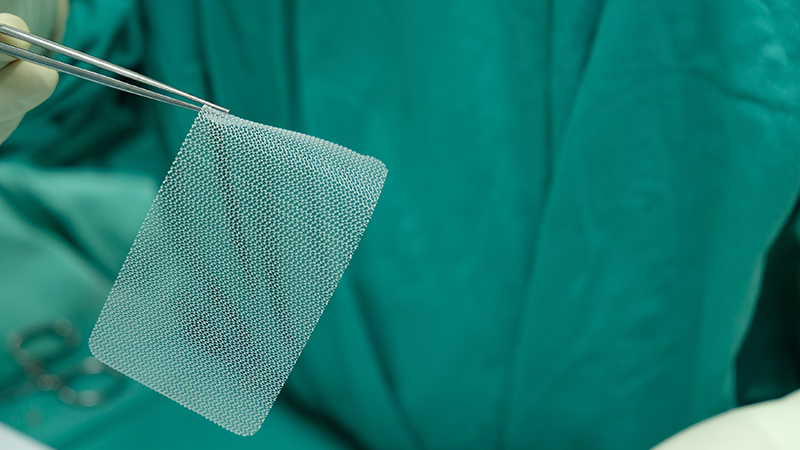Hernia repairs are common, with more than one million hernia repairs performed each year in the United States. Surgical grade mesh is frequently used in hernia repair and is proven to be helpful in reducing the hernia’s return (also known as hernia recurrence, complex hernia). Our listen-first approach to patient care means we hear a lot of questions from our patients about hernia mesh. We want to address the FAQs here.
What is hernia mesh?
Meshes are flat “screens” made of a variety of materials that act as extra barriers to prevent organs or tissue from pressing through the hernia defect. A good visual is that of a woven window screen (though not made of metal). The two most common mesh materials are polypropylene and polyester, which are also used in plastics, fiber, and textile.
To lessen the risk of hernia recurrence, hernia surgeons use suitably-selected, FDA-approved mesh reinforcement for the great majority of inguinal and ventral hernias. Dr. Iskandar will have a detailed discussion with you to hear any questions and concerns you may have. This will include talking about the benefits, drawbacks, and hazards of mesh-based procedures. The Iskandar Complex Hernia Center continues to evaluate new data on mesh materials in order to help select the safest and most appropriate mesh options for our patients.

What is hernia mesh used for?
Hernia mesh, or surgical mesh, is a medical device that reinforces and supports the tissue around a hernia as it heals. Surgeons place the mesh across the area surrounding the hernia. In some cases, the mesh is attached with sutures, staples, glue. Pores in the mesh allow tissue to grow into the device, to make the repair stronger. Hernia mesh is used in nine out of 10 hernia surgeries annually in the U.S.
Experience renowned expertise and
unparalleled compassion
from the leader in hernia repair.
What are hernia meshes made of?
Hernia mesh is made from a variety of materials, and these could be synthetic (made in a lab) or biologic (modified animal tissue). Some meshes are permanent and do not dissolve, and some are absorbable. Mesh selection depends on several criteria such as the location of their hernia, size, risk of infection.
What types of surgical mesh exist?
Surgical mesh can be categorized by their shape or structure:
- Most meshes are flat patches or sheets that go over or under the damaged or weakened tissue.
- Some mesh material comes in the shape of plugs that are typically three-dimensional cones and are placed inside a hole in the tissue. Plugs are less commonly used that flat sheets.
By materials used:
- Synthetic Hernia Mesh is available in woven or non-woven sheets. Synthetic materials can be absorbable, non-absorbable, or a mix of the two. Polypropylene, a synthetic plastic, is used to make the most common types of surgical mesh. Polyester is another type of mesh material.
- Composite or Coated is used when mesh might come into contact with the intestines. This mesh is coated with a film or barrier that prevents the intestines from adhering to or growing into the mesh.
- Biologic Mesh is made from modified or treated animal tissue. It is typically derived from a pig or a cow tissue. It is disinfected and processed by the manufacturers. Most biologic meshes are absorbed in a year or two.
By absorbency:
- Absorbable mesh is designed to act as a scaffolding to allow the tissue to grow into it. As the hernia heals and the tissue becomes stronger, absorbable meshes degrade and lose strength over time.
- Non-absorbable mesh is a permanent implant. It remains in the body indefinitely providing durable support.
By pore size:
- Mesh with larger pores allows for ingrowth of tissue when the surgeon desires to have such a result. Mesh with smaller pores disallows the ingrowth of tissue and is used in cases where ingrowth of tissue is not desired.
By weight:
- Synthetic meshes are grouped as lightweight or heavyweight. The weight of the mesh depends on both the amount of material used and the weight of the polymer.
Are hernia meshes safe now?
The vast majority of people who have a hernia repaired with synthetic mesh recover without issues and are able to resume their normal activities. Multiple clinical studies have shown that mesh repairs carry a lower recurrence rate than non-mesh repairs with a few exceptions. Like any other implantable device, Mesh placement has the potential for problems (e.g., vascular graft, joint or heart valve replacement, etc). Infections, excessive scar tissue, erosion into other organs, chronic discomfort, and other problems are all rare but possible side effects of mesh hernia treatments.
However, the risks of an untreated hernia are more substantial than any risk associated with mesh.
Mesh-related issues could be caused by a variety of variables, including surgical technique, mesh material, anatomy, the quality of the tissue, inflammation, infection, and other physiological reactions, or a combination of factors. It’s crucial to note that some of these issues can also occur in operations that don’t use mesh. Mesh is sometimes utilized in treatments other than hernia repair, such as pelvic surgery, and the difficulties reported in such procedures do not always apply to hernia repair.
Moreover, newer surgical techniques are used where the mesh is placed in between the layers of the abdominal wall keeping the mesh away from the intestines for example which minimizes the risk of mesh-related complications.
How long does hernia mesh last?
Absorbable meshes are designed over time to dissolve into the body and can last on average between six months and two years. Permanent meshes are for long-term reinforcement and do not dissolve.
Can you remove hernia mesh?
In certain conditions where there is mesh infection or an undesirable mesh complication, hernia mesh can be removed.
Mesh can be removed surgically, either through open abdominal surgery or laparoscopic/robotic surgery.
Even if a mesh is recalled, it does not necessarily have to be removed. The majority of mesh used is flat sheets of polypropylene that have been used safely for decades.
What problems can hernia mesh cause?
Mesh is safe and is meant to reduce hernia recurrence. It is rare for mesh to cause a problem, but mesh can be associated with infections, chronic pain, adhesions to the intestines, and erosion into the intestines.
How do I know if mesh was used in my repair?
You can ask your surgeon before or after surgery if the mesh was used in your hernia repair. The best place to obtain that information is the operative report. If it has been some time since your surgery, call your surgeon’s office and inquire. Since 1980 mesh usage has increased. Currently, about 90 percent of hernia surgeries involve mesh, according to the FDA.
How strong is hernia mesh?
Meshes used to repair large hernias need to withstand at least 180 mmHg before bursting. This is easily achieved as even the lightest meshes will withstand twice this pressure without bursting. All synthetic meshes are sufficiently strong.
Can a mesh hernia repair fail?
Depending on the type, size, location and technique for a hernia repair, recurrences range from one to twenty percent. Hernia recurrences are due to several factors, rarely due to mesh failure (meaning the mesh bursting or breaking). Examples of risk factors for hernia recurrence include size, multiple surgeries, and previous repairs, smoking, diabetes, obesity, and poor wound healing.
When a recurrence occurs, it becomes more complex to fix. While Dr. Iskandar performs all types of hernia surgery, he specializes in complex hernia repair surgery.
Experience renowned expertise and
unparalleled compassion
from the leader in hernia repair.
What types of hernias are repaired with mesh?
Most hernia surgery is performed using mesh repair, including:
- Inguinal hernia repair
- Femoral hernia repair
- Umbilical hernia repair
- Hiatal hernia repair
- Incisional hernia repair
- Epigastric hernia repair
- Spigelian hernia repair
- Diaphragmatic hernia repair
Can hernia mesh cause pain years later?
Some of the late complications of hernia repairs with mesh can present several years after surgery. For example, mesh erosion into the intestines usually takes several years. Some chronic pain is also seen when excessive scarring has taken place, causing nerve entrapment.
Can a hernia be repaired without mesh?
Hernias can be repaired without mesh. In certain locations, and especially if the hernia is small, a tissue repair is adequate. Most minimally invasive (laparoscopic and robotic) repairs use mesh. For larger hernias and in certain locations, non-mesh hernia repairs carry a high chance of recurrence.
Does hernia mesh repair require open or laparoscopic surgery?
Hernia mesh can be used with either laparoscopic surgery (aka minimally invasive and/or robotic surgery) or open surgery. The severity of your hernia is more determinative of the type of surgery you receive than the material used to repair it.
We are happy to answer any questions you have about hernia mesh and your hernia surgery. Reach out via a phone call or our contact us form, and we will be in contact with you shortly.


